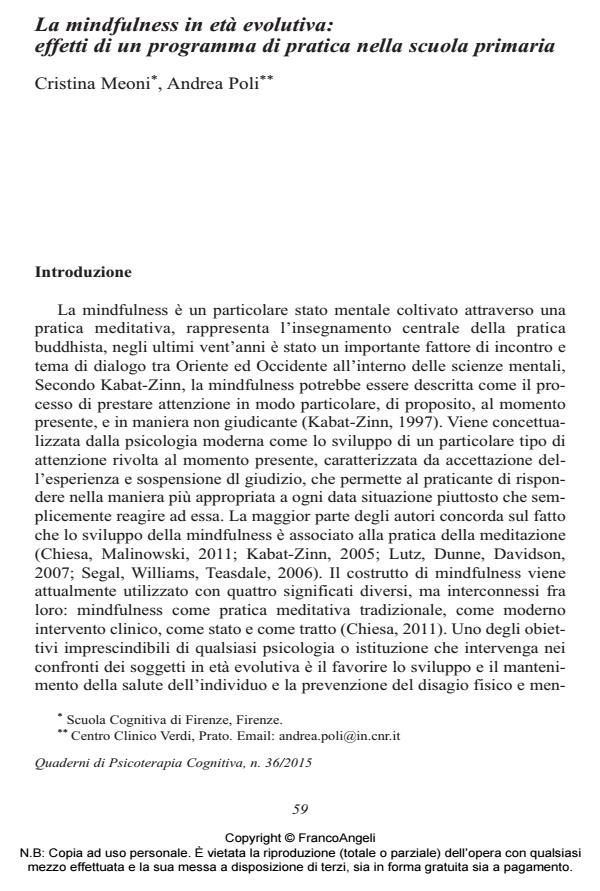Mindfulness during development: effects of a practice program in primary school
Journal title QUADERNI DI PSICOTERAPIA COGNITIVA
Author/s Cristina Meoni, Andrea Poli
Publishing Year 2015 Issue 2015/36
Language Italian Pages 12 P. 59-70 File size 783 KB
DOI 10.3280/QPC2015-036005
DOI is like a bar code for intellectual property: to have more infomation
click here
Below, you can see the article first page
If you want to buy this article in PDF format, you can do it, following the instructions to buy download credits

FrancoAngeli is member of Publishers International Linking Association, Inc (PILA), a not-for-profit association which run the CrossRef service enabling links to and from online scholarly content.
Mindfulness is a particular state of mind reached through meditative practice. The studies published so far demonstrated the effectiveness of a constant and daily mindfulness practice in improving attentional functions and emotional well-being. Recently, mindfulness has started to be applied to study development in children. The aim of this study is to investigate whether a program of mindfulness is effective in reducing the levels of anxiety and depression and in changing the temperamental dimensions in primary school children. 41 subjects (65% males; age: Mean = 10,78, SD = 0,38) attending the fifth year of two classes of a primary school were included in the study. Participants were randomly assigned to the experimental and control groups. The experimental group, but not the control group, was submitted to the mindfulness program, lasting 8 weeks. The program consisted of group sessions, lasting 60 minutes, each week. Temperament was measured through QUIT - Italian Questionnaires of Temperament, while anxiety and depression through TAD - Test for Anxiety and Depression in Childhood and Adolescence. Both instruments were administered to both groups before and after treatment. Results showed that the mindfulness program reduced anxiety levels and was effective in changing the dimensions of temperament: there was an increase in the levels of social orientation, positive emotionality, attention and a reduction in the levels of inhibition to novelty and negative emotionality. Data suggested that mindfulness program is able to change the most important temperament dimensions involved in the interpersonal conflict monitoring: cognitive performance and resilience.
Keywords: Mindfulness, childhood, temperament, anxiety, depression.
Cristina Meoni, Andrea Poli, La mindfulness in età evolutiva: effetti di un programma di pratica nella scuola primaria in "QUADERNI DI PSICOTERAPIA COGNITIVA" 36/2015, pp 59-70, DOI: 10.3280/QPC2015-036005